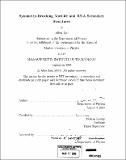Symmetry-breaking motility and RNA secondary structures
Author(s)
Lee, Allen, S.M. Massachusetts Institute of Technology
DownloadFull printable version (3.034Mb)
Alternative title
Symmetry-breaking motility and ribonucleic acid secondary structures
Other Contributors
Massachusetts Institute of Technology. Dept. of Physics.
Advisor
Mehran Kardar.
Terms of use
Metadata
Show full item recordAbstract
This thesis contains work on three separate topics: the spontaneous motility of functionalized particles, the designability of RNA secondary structures, and the statistical mechanics of homopolymer RNAs. For the work on spontaneous motility, we were motivated by in vitro experiments investigating the symmetry-breaking motility of functionalized spherical beads to develop a general theory for the dynamics of a rigid object propelled by an active process at its surface. Starting from a phenomenological expansion for the microscopic dynamics, we derive equations governing the macroscopic velocities of the object near an instability towards spontaneous motion. These equations respect symmetries in the object's shape, with implications for the phase behavior and singularities encountered at a continuous transition between stationary and moving states. Analysis of the velocity fluctuations of such an object reveals that these fluctuations differ qualitatively from those of a passive object. For the work on designability, we investigated RNA folding within a toy model in which RNA bases come in two types and complementary base pairing is favored. Following a geometric formulation of biopolymer folding proposed in the literature, we represent RNA sequences and structures by points in a high-dimensional "contact space." Designability is probed by investigating the distribution of sequence and structure points within this space. We find that one-dimensional projections of the sequence point distribution approach normality with increasing RNA length N. (cont.) Numerical comparison of the structure point distribution with a Gaussian approximation generated by principal component analysis reveals discrepancies. The third and final project concerns the statistical mechanics of homopolymer RNAs. We compute the asymptotics of the partition function Zn and characterize the crossover length scale governing its approach to its leading asymptotic behavior. Consideration of restricted partition functions in which one or more base pairs are enforced leads to an interesting connection with ideal Gaussian polymers. We introduce the notion of gapped secondary structures and analyze the partition function Z?,) for RNAs of length n with gap at p. Another length scale emerges whose scaling agrees with that of the crossover scale found earlier.
Description
Thesis (S.M.)--Massachusetts Institute of Technology, Dept. of Physics, 2005. Includes bibliographical references (p. 61-64).
Date issued
2005Department
Massachusetts Institute of Technology. Department of PhysicsPublisher
Massachusetts Institute of Technology
Keywords
Physics.